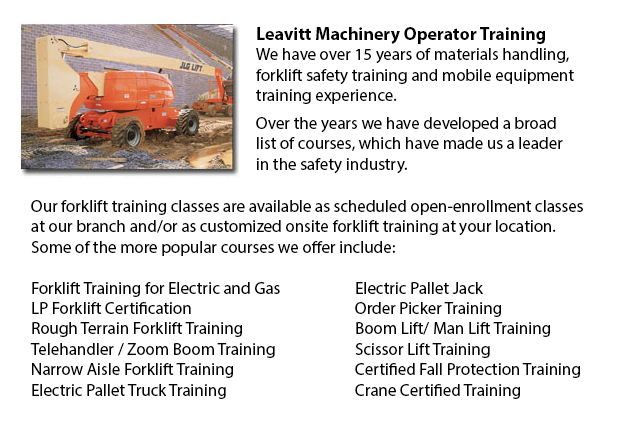
Aerial Lift Safety Training Edmonton - Every year, there are around 26 construction fatalities attributed to the utilization of aerial lifts. Nearly all of the craftsmen killed are laborers, electrical workers, painters, ironworkers or carpenters. Nearly all fatalities are caused by falls, tip-overs and electrocutions. The greatest hazard is from boom-supported lifts, like cherry pickers and bucket trucks. Nearly all fatalities are related to this particular type of lift, with the rest involving scissor lifts. Other risks consist of being struck by falling things, being thrown out of a bucket, and being caught between the lift bucket or guardrail and a thing, like for example a steel beam or joist.
The safe operation of an aerial lift needs an inspection on the following items prior to making use of the device: emergency and operating controls, safety devices, personal fall protection gear, and wheels and tires. Check for possible leaks in the air, fuel-system, hydraulic fluid. Inspect the device for loose or missing components.
The place where the device would be utilized should be carefully examined for potential dangers, such as bumps, holes, drop-offs and debris. Overhead power lines should be avoided or closely monitored. It is recommended that aerial lift devices be utilized on level, stable surfaces. Do not work on steep slopes that exceed slope limitations specified by the manufacturer. Even on a level slope, brakes, wheel chocks and outriggers must be set.
Companies should provide their aerial lift operators with the right instruction manuals. Operators and mechanics must be trained by a qualified person experienced with the applicable type of aerial lift.
Aerial Lift Safety Guidelines:
o Prior to operating, close lift platform chains and doors.
o Do not lean over or climb on guardrails. Stand on the platform or floor of the bucket.
o Stay within manufacturer's load-capacity limitations.
o Utilize work-zone warnings, like cones and signs, when working near traffic.
If right procedures are followed, electrocutions are preventable. Stay at least ten feet away from whichever power lines and certified electricians must insulate and/or de-energize power lines. Individuals working have to make use of personal protective equipment and tools, like insulated bucket. However, an insulated bucket does not protect from electrocution if, for instance, the worker touches another wire providing a path to the ground.
Falls are avoidable if the individual working remains secure in guardrails or inside the bucket by using a positioning device or a full-body harness. If there is an anchorage within the bucket, a positioning belt with a short lanyard is acceptable.
By following the manufacturer's directions, tip-overs can be prevented. Never drive the lift platform while it is elevated, unless the manufacturer specifies otherwise. Adhere to the vertical and horizontal reach limits of the device, and never go beyond the specified load-capacity.
-
Forklift Training Programs Edmonton
Forklift Training Programs Edmonton - If you are searching for work as an operator of a forklift, our regulatory-compliant lift truck training programs provide excellent instruction in numerous styles and types of forklifts, classes on pre-shift insp... More -
Heavy Equipment Training School Edmonton
Heavy Equipment Training School Edmonton - The heavy equipment operator courses will assist the operator in acquiring the required skills and knowledge they will require to be able to enter the workforce as an entry level operator. In this 12 week co... More -
Manlift Ticket Edmonton
Manlift Ticket Edmonton - The Elevated Platforms and Manlifts Certification program helps to provide the necessary training on the safe operating procedures, work practice, rules and regulations regarding the daily activities for the operators of thi... More -
Crane License Edmonton
Crane License Edmonton - Crane operators must be "credentialed", which means they must have a crane operator license or certification. Credentialing is considered a mandatory governmental requirement in order to practice as a crane operator. Having a... More -
Counterbalance Forklift License Edmonton
Counterbalance Forklift License Edmonton - When operated by totally trained operators, forklifts could become a major advantage for firms and companies. We could offer your staff a comprehensive training program which covers all aspects of operating... More -
Manlift Safety Training Edmonton
Manlift Safety Training Edmonton - Manlift operators have to be aware and cognizant of all the potential hazards which are associated with particular types of scissor lifts. They need to be able to operate the scissor lift in a way that protects not... More -
Forklift Training School Edmonton
Forklift Training School Edmonton - Forklift Training School And Reasons Why It Is Really Important - Industry and federal regulators have established the criteria for forklift safety training based on their existing standards and regulations. Indivi... More -
Overhead Crane Safety Training Edmonton
Overhead Crane Safety Training Edmonton - The overhead crane safety training course is designed to equip the operators with the right skills and knowledge in the areas of: crane safety precautions, materials handling, accident avoidance, and equipmen... More

Forklift Training Edmonton
crossorigin="anonymous">
TOLL FREE: 1-888-254-6157
Edmonton, Alberta
forklifttrainingedmonton.com
Email Us
About Us


